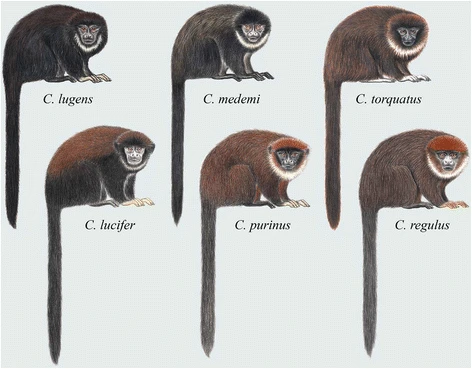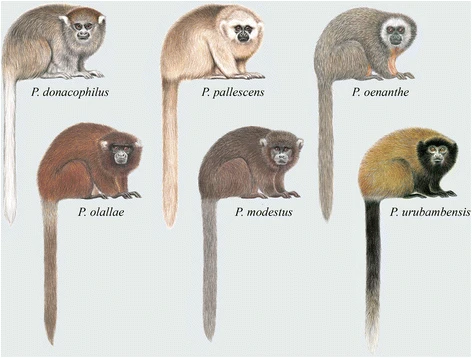|
Callicebinae
The titis, or titi monkeys, are New World monkeys of the subfamily Callicebinae, which contains three extant genera: ''Cheracebus'', ''Callicebus'', and ''Plecturocebus.'' This subfamily also contains the extinct genera '' Miocallicebus, Homunculus'', and ''Carlocebus''. Titi monkeys live in South America, from Colombia, Ecuador and Peru, east through Brazil, and south to Bolivia and northern Paraguay. Description Depending on species, titis have a head and body length of , and a tail, which is longer than the head and body, of . The different titi species vary substantially in coloring, but resemble each other in most other physical ways. They have long, soft fur, and it is usually reddish, brownish, grayish or blackish, and in most species the underside is lighter or more reddish than the upperside. Some species have contrasting blackish or whitish foreheads, while all members of the genus ''Cheracebus'' have a white half-collar. The tail is always furry and is not prehensil ... [...More Info...] [...Related Items...] OR: [Wikipedia] [Google] [Baidu] |
Brown Titi
The brown titi monkey (''Plecturocebus brunneus'') is a species of titi monkey, a type of New World monkey, from South America. It is endemic to Brazil. It was originally described as ''Callicebus brunneus'' in 1842 and transferred to the newly erected genus ''Plecturocebus'' in 2016. Taxonomy ''Plecturocebus'' are within a subfamily of titi called Callicebinae. Other genera included within this subfamily are the '' Cheracebus'', ''Callicebus'', and ''Plecturocebus;'' which are all still currently extant. The '' Xenothrix, Antillothrix'', '' Paralouatta, Carlocebus, Lagonimico'', and ''Tremacebus'' genera of Callicebinae are extinct. The Urubamba brown titi (''P. urubambensis'') of Peru was formerly thought to be a Peruvian population of ''P. brunneus'', but a 2015 study found it to be a distinct, undescribed species more closely related to the white-eared titi (''P. donacophilus''), and described it as such. The Brown Titi was classified as its own genus in 2016. Due to the p ... [...More Info...] [...Related Items...] OR: [Wikipedia] [Google] [Baidu] |
Cheracebus
''Cheracebus'' is one of three genera of titi monkeys. Monkeys in this genus, particularly the type species '' Cheracebus lugens'', are sometimes referred to as widow titi monkeys. Historically, titis were monogeneric, comprising only the genus ''Callicebus'' Thomas, 1903. Owing to the great diversity found across titi monkey species, a new genus-level taxonomy was recently proposed that recognises three genera within the subfamily Callicebinae; ''Cheracebus'' Byrne et al., 2016 for the species of the ''torquatus'' group (Widow titis); ''Plecturocebus'' Byrne et al., 2016 for the Amazonian and Chaco titis of the ''moloch'' and ''donacophilus'' groups; and ''Callicebus ''Callicebus'' is a genus of monkeys known as titi monkeys. Historically, titis were monogeneric, comprising only the genus ''Callicebus'' Thomas, 1903. Owing to the great diversity found across titi monkey species, a new genus-level taxonomy w ...'' Thomas, 1903 ''sensu stricto'', for species of the Atlantic Fo ... [...More Info...] [...Related Items...] OR: [Wikipedia] [Google] [Baidu] |
Callicebus
''Callicebus'' is a genus of monkeys known as titi monkeys. Historically, titis were monogeneric, comprising only the genus ''Callicebus'' Thomas, 1903. Owing to the great diversity found across titi monkey species, a new genus-level taxonomy was recently proposed that recognises three genera within the subfamily Callicebinae The titis, or titi monkeys, are New World monkeys of the subfamily Callicebinae, which contains three extant genera: ''Cheracebus'', ''Callicebus'', and ''Plecturocebus.'' This subfamily also contains the extinct genera '' Miocallicebus, Homuncu ...; '' Cheracebus'' Byrne et al., 2016 for the species of the ''torquatus'' group (Widow titis); '' Plecturocebus'' Byrne et al., 2016 for the Amazonian and Chaco titis of the ''moloch'' and ''donacophilus'' groups; and ''Callicebus'' Thomas, 1903 ''sensu stricto'', for species of the Atlantic Forest ''personatus'' group. In 2014, a previously unknown orange ''Callicebus'' was spotted in the Peruvian Amazon; it ... [...More Info...] [...Related Items...] OR: [Wikipedia] [Google] [Baidu] |
Plecturocebus
''Plecturocebus'' is one of three genera of titi monkeys. Historically, these monkeys were monogeneric, being placed in a single genus: ''Callicebus'' Thomas, 1903. Owing to the great diversity found across titi monkey species, a new genus-level taxonomy was proposed in 2016 that recognises three genera within the subfamily Callicebinae; ''Plecturocebus'' Byrne et al., 2016 for the Amazonian and Chaco titis of the ''moloch'' and ''donacophilus'' groups; '' Cheracebus'' Byrne et al., 2016 for the species of the ''torquatus'' group (Widow titis); and ''Callicebus'' Thomas, 1903 ''sensu stricto'', for species of the Atlantic Forest ''personatus'' group. ''Plecturocebus'' is derived from the Latin forms of three Greek words: plektos, meaning twist or plait, oura, meaning tail, and kebos, meaning long-tailed monkey. All together, this refers to the behavior of many titi monkeys to intertwine their tails when they sit next to each other. Species There are 25 species in this genus: *' ... [...More Info...] [...Related Items...] OR: [Wikipedia] [Google] [Baidu] |
New World Monkey
New World monkeys are the five families of primates that are found in the tropical regions of Mexico, Central and South America: Callitrichidae, Cebidae, Aotidae, Pitheciidae, and Atelidae. The five families are ranked together as the Ceboidea (), the only extant superfamily in the parvorder Platyrrhini (). Platyrrhini is derived from the Greek for "broad nosed", and their noses are flatter than those of other simians, with sideways-facing nostrils. Monkeys in the family Atelidae, such as the spider monkey, are the only primates to have prehensile tails. New World monkeys' closest relatives are the other simians, the Catarrhini ("down-nosed"), comprising Old World monkeys and apes. New World monkeys descend from African simians that colonized South America, a line that split off about 40 million years ago. Evolutionary history About 40 million years ago, the Simiiformes infraorder split into the parvorders Platyrrhini (New World monkeys) and Catarrhini ( apes and Old Worl ... [...More Info...] [...Related Items...] OR: [Wikipedia] [Google] [Baidu] |
Miocallicebus
''Miocallicebus'' is an extinct genus of New World monkeys from the Middle Miocene (Laventan in the South American land mammal ages; 13.8 to 11.8 mya). Its remains have been found at the Konzentrat-Lagerstätte of La Venta in the Honda Group of Colombia. The type species is ''Miocallicebus villaviejai''.''Miocallicebus villaviejai'' at Fossilworks.org Etymology ''Miocallicebus'' is derived from the Greek name for the modern genus of s, ''Callicebus'', with the prefix ''Mio'' for Miocene. The[...More Info...] [...Related Items...] OR: [Wikipedia] [Google] [Baidu] |
Subspecies
In biological classification, subspecies is a rank below species, used for populations that live in different areas and vary in size, shape, or other physical characteristics ( morphology), but that can successfully interbreed. Not all species have subspecies, but for those that do there must be at least two. Subspecies is abbreviated subsp. or ssp. and the singular and plural forms are the same ("the subspecies is" or "the subspecies are"). In zoology, under the International Code of Zoological Nomenclature, the subspecies is the only taxonomic rank below that of species that can receive a name. In botany and mycology, under the International Code of Nomenclature for algae, fungi, and plants, other infraspecific ranks, such as variety, may be named. In bacteriology and virology, under standard bacterial nomenclature and virus nomenclature, there are recommendations but not strict requirements for recognizing other important infraspecific ranks. A taxonomist decides whe ... [...More Info...] [...Related Items...] OR: [Wikipedia] [Google] [Baidu] |
Monogamous
Monogamy ( ) is a form of dyadic relationship in which an individual has only one partner during their lifetime. Alternately, only one partner at any one time ( serial monogamy) — as compared to the various forms of non-monogamy (e.g., polygamy or polyamory). The term is also applied to the social behavior of some animals, referring to the state of having only one mate at any one time. A monogamous relationship can be sexual or emotional, but it's usually both. Many modern relationships are monogamous. Terminology The word ''monogamy'' derives from the Greek μονός, ''monos'' ("alone"), and γάμος, ''gamos'' ("marriage").Cf. "Monogamy" in ''Britannica World Language Dictionary'', R.C. Preble (ed.), Oxford-London 1962, p. 1275:''1. The practice or principle of marrying only once. opp. to digamy now ''rare'' 2. The condition, rule or custom of being married to only one person at a time (opp. to polygamy or bigamy) 1708. 3. Zool. The habit of living in pairs, o ... [...More Info...] [...Related Items...] OR: [Wikipedia] [Google] [Baidu] |
Gestation
Gestation is the period of development during the carrying of an embryo, and later fetus, inside viviparous animals (the embryo develops within the parent). It is typical for mammals, but also occurs for some non-mammals. Mammals during pregnancy can have one or more gestations at the same time, for example in a multiple birth. The time interval of a gestation is called the '' gestation period''. In obstetrics, '' gestational age'' refers to the time since the onset of the last menses, which on average is fertilization age plus two weeks. Mammals In mammals, pregnancy begins when a zygote (fertilized ovum) implants in the female's uterus and ends once the fetus leaves the uterus during labor or an abortion (whether induced or spontaneous). Humans In humans, pregnancy can be defined clinically or biochemically. Clinically, pregnancy starts from first day of the mother's last period. Biochemically, pregnancy starts when a woman's human chorionic gonadotropin (hCG) ... [...More Info...] [...Related Items...] OR: [Wikipedia] [Google] [Baidu] |
Amazon Basin
The Amazon basin is the part of South America drained by the Amazon River and its tributaries. The Amazon drainage basin covers an area of about , or about 35.5 percent of the South American continent. It is located in the countries of Bolivia, Brazil, Colombia, Ecuador, Guyana, Peru, Suriname, and Venezuela. Most of the basin is covered by the Amazon rainforest, also known as Amazonia. With a area of dense tropical forest, this is the largest rainforest in the world. Geography The Amazon River begins in the Andes Mountains at the west of the basin with its main tributary the Marañón River and Apurimac River in Peru. The highest point in the watershed of the Amazon is the second biggest peak of Yerupajá at . With a length of about before it drains into the Atlantic Ocean, it is one of the two longest rivers in the world. A team of scientists has claimed that the Amazon is longer than the Nile, but debate about its exact length continues. The Amazon s ... [...More Info...] [...Related Items...] OR: [Wikipedia] [Google] [Baidu] |
Species
In biology, a species is the basic unit of classification and a taxonomic rank of an organism, as well as a unit of biodiversity. A species is often defined as the largest group of organisms in which any two individuals of the appropriate sexes or mating types can produce fertile offspring, typically by sexual reproduction. Other ways of defining species include their karyotype, DNA sequence, morphology, behaviour or ecological niche. In addition, paleontologists use the concept of the chronospecies since fossil reproduction cannot be examined. The most recent rigorous estimate for the total number of species of eukaryotes is between 8 and 8.7 million. However, only about 14% of these had been described by 2011. All species (except viruses) are given a two-part name, a "binomial". The first part of a binomial is the genus to which the species belongs. The second part is called the specific name or the specific epithet (in botanical nomenclature, also sometimes i ... [...More Info...] [...Related Items...] OR: [Wikipedia] [Google] [Baidu] |







